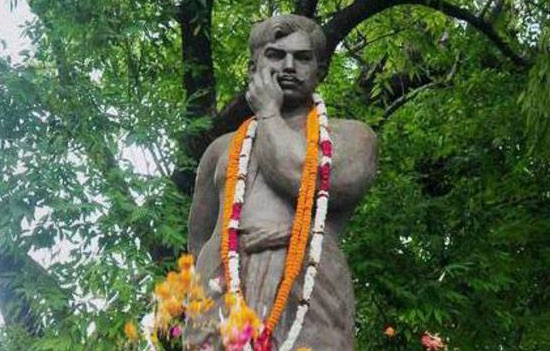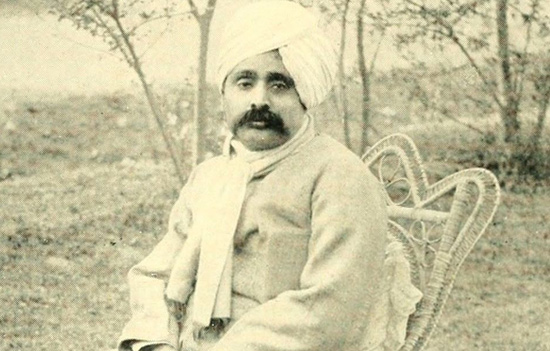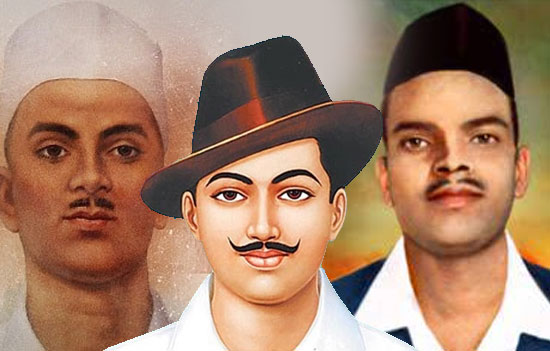- Shivaram Rajguru of Maharashtra was one of the 3 hanged that day, the
other two being Bhagat Singh and Sukhdev Thapar. Rajguru was 23 years when
hanged. Know his life story.
March 23 Lahore central Jail - In barrack number 14, some revolutionaries were having
discussions and suddenly one man said,
“I am, like you, proud of what I have accomplished. I have come to realize this truth only after challenging death. If we are able to show even a glimpse of the freedom to our fellow nationals by sacrificing our lives, they would be able to walk on that path by themselves. This death, then, would be blessing for us.” That man was Shivaram Hari Rajguru.
British rule of
India was one of the darkest chapter of our history. They damaged India from
within. Indian became independent of the British but for this she lost many heroes.
Some of them became idols and known to each and every Indian. But many of them are
unknown. Shivram Hari Rajguru is one of them.
Rajguru was born
to Hari Narain and Parvati Devi on August 24, 1908 in Khed (Maharashtra). His
father died when he was only six years old. His elder brother Dinkar joined
government service due to the sudden demise of his father. Shivram was a bright
child. He had mastery in Sanskrit and was a trained wrestler.
Shivaram, in his
youthful zeal, decided to devote himself to the freedom struggle. He started
developing physical and mental strength by vigorous exercises like wrestling,
and swimming in Bheema river, a habit that he cultivated during childhood. He toughened
up so much that once he broke a hot lamp glass between his fists. He was quiet
adept with sling shot, which served to refine his accurate target practice.
After marriage his brother Dinkar and family shifted to Pune. Dinkar’s pro-British Government servant attitude was in absolute contrast with Shivram’s nationalist zeal. Due to this major difference relations between the brothers worsened. In 1924, during a heated argument Dinkar asked his brother Rajguru to leave the house if he could not change his attitude towards the British and concentrate on his studies instead.
This proved to be
a god sent opportunity for Rajguru to break free from family ties without
feeling guilty and devote himself to Bharat. He immediately touched the feet of
both his elders and walked out.
Shivram left home
at age of 16, with patriotic zeal and a pledge to uproot the tyrannical British
rule. From Pune he went to Kashi where he met an old family friend Pandurang Pant
who very kindly made arrangements for his earnings and living.
Drastic changes now took place in Rajguru’s lifestyle. His day started at 5.a.m. After morning routine activities, bath and washing of clothes he returned to his room by 6.30 a.m. Then after going for Madhukari (bhiksha) in five houses at around 10.a.m. he attended classes from 12.30 to 2.p.m. After an hour’s rest, he resumed with revision and home work. Six to 8.30 p.m. he took leisure strolls and then dinner. He retired to bed usually by 8.30.
Then many
Maharashtrian laureates resided at Kashi. He received education at Sangved Sanskrit
School from Ved Murthy Baba Patwardhan. Due to his intellect, he was a favourite
student and obtained a Madhyama (degree) in Tarkashastra (branch of Sanskrit education).
But in all of this
Rajguru did not find way of revolution, for which he had left his house.
Suddenly, one day a friend Savargaonkar arranged a meeting with Baba Rao
Savarkar. This was life changing moment for Rajguru.
Impressed with his
patriotic zeal Baba Rao directed Rajguru to join Hanuman Vyayam Prasarak Mandal,
a voluntary cultural organization in Amravati (Maharashtra). The mandal was established
in 1914 by Vaidya brothers, Anant Krishna and Amba Das, with the dual objective
of developing physical and mental strength by promoting sports and culture and boosting
national zeal among the youth. Rajguru borrowed money from Shri Prakash, close
aide of Babarao Savarkar and left for Amravati.
There Rajguru
joined the summer camp for physical training, organized at Pannalal Garden and
started rigorous training. He soon acquired the degree of Vyayam Visharad (Master of Physical Training). At times, he
indulged in adventurous acts like roaming in dark in the forest and jumping
into the well. He also learnt shooting with a gun, and soon mastered its use.
After this calm period Rajguru left for Kashi where life took a different shape. Vaishampayan, at that time, was working as head clerk in the office of Jhansi, but in reality was an under-cover revolutionary and a close aide of freedom fighter Chandrasekhar Azad. He, on Azad’s instruction, had come to Kashi to find new recruits and strengthen communication links.
Vaishampayan was deeply influenced by Rajguru’s self-confidence, determination and love for the nation. He told Shivram that he too belonged to Maharashtra and was trying to gain entry in some revolutionary group, while staying at Kanpur. Rajguru informed him that he held similar views and was keen to join such a group, if Vaishampayan found any. “Once Rajguru was seen touching a hot iron rod with his hands and when Chandra Shekhar Azad inquired about this insanity, he smiled calmly and said that he was testing himself if he can bear police torture.”
 Chandrasekhar Azad.
Chandrasekhar Azad.
On the recommendation of Vaishampayan, Azad contemplated that the youth deserved a chance and agreed to interview Rajguru at Kanpur. In the interview, Azad was highly impressed by Rajguru’s attitude, self-confidence, honesty and agreed to make Rajguru part of his team. Rajguru’s joy knew no bound as his life-long ambition was being fulfilled.
He was assigned a codename
Raghunath and also referred as M. Rajguru and fellow revolutionaries lived in
DAV college hostel, Kanpur. At that time, DAV College was a hub of
revolutionaries and nationalists.
The first task
assigned to Rajguru was to take care of Delhi resident, Hassan Nizami who was
creating headaches for society and revolutionaries, in particular. He and Shiv Verma went to kill Hassan Nizami. They
observed that he stopped his car and was going into his home. Rajguru shot but by
mistake shot the father-in-law of Hassan Nizami.
During this period
he met with Bhagat Singh, who later became a close friend. Around the same time
revolutionary cadres who were scattered all over were trying to work together. Young
revolutionaries from all over India, arranged a meet for further action and
works. It resulted in the formation of the Hindustan
Socialist Republic Association. “He was also an accurate shooter which earned him the title of the gunman of HSRA.”
The British under
cover of The Government of India Act 1919, was mercilessly suppressing the voice
of hapless Indians all over. Under such circumstances, on November 8 1927, the
Viceroy announced that a high level Commission had been appointed by the
British Prime Minister. The members would tour India and submit a report to the
Government, including suggestions on administrative Reforms.
 Lala Lajpat Rai.
Lala Lajpat Rai.
This commission
was opposed all over India. The Lahore unit of revolutionaries, arranged a huge
protest against this commission under the leadership of Lala Lajpat Rai. Protests
were vigorous. British cop Scott ordered a lathi charge on unarmed people.
Saunders and other officers attacked protesters. They injured Lala Lajpat Rai seriously.
Lalaji was hospitalized for treatment. After eighteen days, Lalaji succumbed
and died on November 17, 1928. The nation mourned his death.
The Lahore unit of
revolutionaries were anxious to avenge the death of Lalaji. They finally
decided to do so by killing Scott. Everybody volunteered but Sukhdev Thapar was chosen by the group as the coordinator
for this mission.
Sukhdev named
Azad, Bhagat Singh, Rajguru and Jai Gopal as his accomplices to accomplish the
task. At around 4 p.m., Jai Gopal stood with a bicycle on the road in front of
Police Headquarters, pretending to do some repairs. Rajguru and Bhagat Singh
were standing slightly away from the main gate. Gopal saw a European Police
Officer, wearing a felt cap, start a red coloured motorcycle. The confusion was
still persisting, was he Scott?
He mistook John Saunders
for James Scott and made the fateful signal to Rajguru. Saunders started moving
slowly towards the main gate. As he (Saunders) neared, Rajguru
at once fired. The shot was accurate. The bullet pierced the chest and John
Saunders collapsed on the ground, with one leg under the running motorcycle.
Bhagat Singh immediately realized that they had picked the wrong man but had no
option. He fired several shots at Saunders to make sure that he was dead. They
escaped narrowly after a close chase by police.
 Tridev of Rajguru, Bhagat Singh and Sukhdev.
Tridev of Rajguru, Bhagat Singh and Sukhdev.
Arresting the
killers proved to be a big challenge for the British government. They started
fierce investigations but in vain.
After this, revolutionaries
planned to bomb inside the Assembly to oppose the tyrannical laws. Bhagat Singh
and Batukeshwar Dutt, threw bombs in the Assembly and got arrested. After this,
all revolutionaries met at Delhi for further planning. This was the last
meeting between Rajguru and Azad. After this, Rajguru returned to Jhansi and later
to Amravati.
He joined the
summer camp at the gymnasium, maintained by Hanuman Prasarak Mandal to continue
with exercises. He started motivating youth in nationalistic thinking. One day
he abruptly left the place as he suspected the presence of detectives amongst the
followers. Thereafter, Rajguru lived in Akola, Washim for a short period and
finally returned to Pune with the help of Babarao Saheb. Here he met his mother
and brother, albeit after a long time.
His elder brother Dinkar was now living at 408 Narain Peth. Rajguru often visited the house for meals. Once Dinkar and his mother saw a gun in the coat pocket (as Rajguru had gone out after hanging the coat on the peg) and were terrified. On return, mother asked Rajguru, “How did you come to possess it? A Pandit looks better holding noble books in his hands, not the guns.”
Rajguru, with all seriousness, replied, “Mother, When the religion or the nation is in trouble, only arms are useful. The British are inflicting all sorts of insults and injuries on us and I do not expect them to refrain from such activities merely by requesting them. If you remember, even in Vishnu Sahastranaam, one of the names for Lord
Vishnu is Sarv Praharanayuddh (one who always remains decorated with arms).”
After returning
from Kashi he planned to kill the Governor of Bombay with the help of his revolutionary
friend Savargaonkar. The plan failed due to large police presence.
In the meantime, Rajguru came in contact with Sharad Keskar, nephew of a renowned Congress leader. In reality Keskar was a police informer and had been hired by British Intelligence to track Rajguru. Keskar wanted more information about Rajguru’s arms and ammunition, so he said that for killing the Governor they needed a gun, being proficient in lathi work was not sufficient. Rajguru told him everything, without knowing that Keskar was an informer.
Rajguru was eager to kill the Bombay Governor. Keskar informed him about the Governor’s visit to Race Course to attend a function related to Governor’s Cup. Keskar was under the control of Holland, D.I.G., C.I.D., Bombay through Kavthalkar, a local C.I.D. Officer. On Holland’s orders, the Lahore Police escorted Jai Gopal to Race Course, Pune, while keeping his face under veil.
Rajguru, totally
unaware of the conspiracy, returned from a funeral and after taking bath, left for
the Race Course alone without even informing Savargaonkar. The place had heavy
police security and Rajguru was unable to penetrate it. The police and Keskar
identified Rajguru as the killer of Saunders and on 30 September, they arrested
Rajguru and Savargaonkar by raiding their room. The Lahore Police escorted
Rajguru and Savargaonkar from Pune to Lahore.
“All of them along with other 21 co-conspirators were tried and found guilty for the murder of Saunders. During the court proceedings Rajguru, to annoy the judge, deliberately replied in Sanskrit. When the baffled British judge used to shout at him, he used to have a good laugh and nudge Bhagat to translate.”
At Lahore, Bhagat
Singh and other colleagues were on hunger strike inside the jail. To support
them both stopped taking meals right from the start of their journey. The news
about their arrest had already spread like wildfire throughout the country.
People flocked in hundreds and thousands at all railway stations to catch a
glimpse of their heroes, Rajguru and Savargaonkar. Despite being famished
because of no meals both greeted people with patriotic slogans, followed by
similar echoes from the crowd.
All the
revolutionaries in jail, started hunger strike against the evil and partial treatment
of government towards the revolutionaries. On thirteenth day, they were
forcefully feed. In the meantime, Chandrasekhar
Azad tried to rescue them from jail, but failed. The days were passing and changing
the fate of our revolutionaries.
On December 7 1930
Bhagat Singh, Sukhdev and Rajguru were sentenced to death. As per provisions of
solitary detention for death sentence of the Jail Manual Bhagat Singh, Rajguru
and Sukhdev were to be transferred to separate cells. They embraced each other
warmly and started their journey to their respective barracks.
The Tridev were
hanged at 7.33 p.m. amidst deafening shouts of patriotic slogans, from inside
and outside the Jail. The light of their life was extinguished, but their
sacrifice ignited the torch of freedom.
“As a tribute to him, his birth place Khed was renamed as Rajgurunagar. His ancestral home is now known as the Rajguru Wada.” Rajguru was 23 years old when hanged.
In the sacred
yagya of freedom struggle, Shivaram Hari Rajguru became the unknown Ahuti. His
works, deeds and his patriotism will inspire our youth for ages.
To read all
articles by author
References
1. Rajguru the invincible by Anila Varma
2. Without fear by Kuldeep Nayyar
3. Dictionary of martyrs of India's freedom struggle
4. Struggle for freedom by R C Majumdar
Also
read
1. Freedom
Struggle in Punjab
2. Lala
Lajpat Rai gave a fillip to the Independence Movement
3. About
Bhagat Singh
4. Lal Pal Bal, tridev of India’s freedom movement in the early 19th
century
5. Remembering
Rajguru
6. Little
known facts about Rajguru